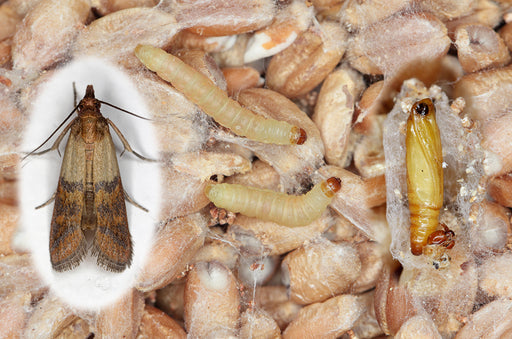How to Get Rid of Moths in Your Camper

If you are getting ready for a trip in your camper and notice signs of moths, you are not alone. Moths can be incredibly pesky and love campers that have been sitting parked for a while! Some moths can even cause damage to your camper’s interior.
Want to make sure your camper or recreational vehicle is moth free? Understanding the most common causes of Clothes Moths, Pantry Moths, and Carpet Moths can help. Below, we will talk about what causes moths to infest a camper and how to get rid of them for good! That way, you can proceed with your annual vacation as planned without any unwanted stowaways.
Why Are There Moths in My Camper?
Moth infestations can be caused by many things. If you notice lots of moths in your camper, it could be that a generation of undisturbed moth eggs have hatched, gone through the larval stages, and are now ready to find mates. Or, it may simply be that moths have flown into your camper looking for lights to flutter into while you were parked out in the woods. It will all depend on the type of moth you are dealing with and the circumstances of your situation.
Some types of moths can be quite destructive to your belongings. Although small in stature, Carpet and Clothes Moth Eggs can unleash untold devastation after hatching. In the larval stage, both of these species of moths eat through fabrics, fibers, and other materials, causing costly damage and massive headaches. Pantry Moths can be troublesome in campers as well.
How to Get Rid of Moths in Your Camper or Motorhome: Five Effective Options

Here are five effective ways to deter or get rid of moths in a camper, RV, or motorhome.
1. The best offense is always a good defense when it comes to moth infestations. First off, try using natural materials that safely repel moths. Cedar and oils and natural sprays are incredibly useful for deterring moths. Moths and many other types of insects are repulsed by the pheromones in cedar. Dried herbs can be helpful as well.
Herbs like lavender, mint, bay leaves, cloves, thyme, and rosemary have odors that moths hate but people tend to enjoy. In a small space like a motorhome, these fragrant herbs are pleasant and not overpowering. They are also safe for pets and people to smell. Many of these herbs also come in essential oil diffuser format. You may also want to consider using cedar shelving if you are doing any DIY maintenance in your camper.
2. Always keep things tidy. Vacuum, dust, and mop regularly. Cleaning your recreational vehicle after a trip is important. Make sure to take out any blankets and linens and wash them. Wipe out cupboards with white vinegar and do not keep unsealed food stored in your camper if it will not be used for a while.
3. Use Moth Traps. These traps are non-toxic, odor free and safe for use around children and pets. They catch the active adult male moths, therefore helping break the breeding cycle and enable you to gauge the size of the your moth problem. This in turn means that there will be less female moths laying eggs in your RV or camper.
If you notice signs of moths in any fabric items that can’t be washed, freeze them for up to 72 hours if possible. This will kill moth larvae and eggs. If possible, wash curtains, seat covers, and items made of natural materials that show any signs of a moth infestation.
4. Use white vinegar to kill eggs and larvae. Vinegar is great for safely killing moths in small spaces. Wash and scrub down any areas you discover larvae or eggs using a potent vinegar and water solution.
5. If you have a major moth infestation that is recurring in your camper, you may need to take further action. Our Clothes Moth Kit Guide gives you information on how to use chemical products in line with our Traps to rid your camper of Clothes Moths. Or in extreme circumstances a professional pest control service might be necessary.
Important: Considerations When Treating Moths in Camper or RV Living Spaces
A pest control service may not always be needed for a serious infestation. However, you should proceed with consideration when using a chemical-based treatment (sprays, powders, foggers, fumigation, etc.) to kill moths in a camper or RV.

Handle the enclosed living spaces in a camper in the same way you would an apartment with an open living plan or a kitchen where food is prepared often. After all, you want to make sure you safely rid your camper of moths without harming your loved ones or pets.
To learn more about this you can read our Clothes Moth Kit Guide.
What types of moths can infest a camper?
When it comes to damage to the interior of your recreational vehicle or camper, Clothes Moths, Carpet Moths, and Pantry Moths are the most problematic because they lay eggs that then hatch into hungry and destructive larvae.
Pantry Moths are often brought into the campers accidentally in the egg or larval stage via an infested grain, cereal, or dry good items. Clothes Moths can be carried in on blankets or fly in through an open window while your camper is parked. Moths will lay eggs where abundant food sources are readily available.
Carpet/Clothes Moth Larvae are the most damaging to a camper’s materials and interior as a whole. Sometimes, Pantry Moth Larvae can be a problem as well, especially if you have food items stored in your camper or RV.
Garden moths aren't usually an issue, they would normally only seek shelter in a vehicle like a camper temporarily. If you camp high in the mountains, you may be visited by a range of moths, but these migrating moths (such as Miller Moths) aren’t anything to worry about. They can just be an annoying fluttering intrusion in your space.
Finally, other kinds of moths can be attracted to lights left on in your camper at night. Usually, these moths are annoying, but won’t want to lay eggs in your camper. They can simply be shooed away. Really, it’s the nesting, pestilent (Clothes, Carpet and Pantry) Moths you should watch for.

What do Clothes and Carpet Moth Larvae eat?
Clothes and Carpet Moth Larvae are interested in eating textiles like silk, wool, fur, and leather. Clothes Moths are a concern if your camper's interior has any materials which contain animal based fibers. If you have pets that travel with you, any shed pet hair may also attract Clothes Moths. Clothes stored in the closet, blankets, sleeping bags, and other fabric items may also attract Clothes Moths to a camper.
Clothes and Carpet Moths will lay eggs inside of a camper wherever a food source is easily accessible for larvae when they hatch. This may even be in out-of-the-way places like under the carpets, between the seats, or in the roof lining.
How to Get Rid of Pantry Moths in a Camper?
Pantry Moths (Indian Meal Moths) are attracted to lay their eggs on dry grain and cereal items like flour, rice, dried fruits, and even chocolate! They are also drawn to Pet food. So, if you have any of these foodstuffs stored in your camper cupboards, Pantry Moths could become a problem.
Generally, Pantry Moths will not damage the upholstery or materials in a camper. However, if there are lots of crumbs or food remnants ground into your upholstery, you may still wind up with some amount of material damage.
To get rid of Pantry Moths in a camper first eliminate any infested items and then clean your camper cupboards thoroughly with white vinegar. Check your food i for signs of larval activity (casings, dead larvae, etc.) and toss out anything that shows signs of damage. Then, use natural moth repellents to help prevent reinfestation.

How to Get Rid of Clothes Moths in a Camper?
To get rid of Clothes Moths, you should first find the source of the infestation. Usually, this will be in an animal-based fiber like wool, silk, or even feathers, fur, or leather. If an item cannot be hot-washed, freeze it for 72 hours to kill moth larvae and eggs.
You should also thoroughly clean your camper from top to bottom using moth-killing solutions. White vinegar helps eliminate moth eggs and larvae, but for larger infestations you may need a chemical spray too.
For information on eliminating larger infestations, you may like to read our Clothes Moth Kit Guide, which gives you guidance about using chemical products in line with our Traps.
The goal is to find the source of the infestation, eliminate it, and then use moth deterrents to keep the insects from nesting there in the future.
FAQs on Eliminating Moths in Campers
Okay, so now that you get the gist of things, let’s go over some useful FAQs about moths in campers, RVs, and other recreational vehicles.
How do I keep moths out of my camper in the first place?
There are many ways to keep moths out of a camper, mobile home, or RV. Natural herbs like rosemary, lavender, thyme, mint, and cloves help deter moths. Cedar is another amazing natural moth repellent. Close all doors and windows and remove unsealed food from your cupboards when your camper is not in use. Also, keep your lights turned off at night to avoid attracting moths when you are out camping in the woods or other areas that are heavily infested with insects.
How do you get rid of a moth infestation?
First, identify what type of moth infestation you have. Then, eliminate it at its source. There are natural and chemical elimination methods available to get rid of moths in a camper. Clean thoroughly afterward and take preventative measures to keep moths from returning.
Should I use mothballs in my camper?
This should be avoided, as they are made with harsh chemicals and the smell will linger strongly in a camper.
What scent will keep moths away?
Cedar, thyme, lavender, clove, mint, and rosemary are all scents that moths hate.
Why are moth wings dusty?
The wings of a moth are dusty because they are covered in petite scales. The tiny scales serve as an insulating layer and protect the moth from becoming too cold.

About MothPrevention
MothPrevention® speak to customers every day about their clothes moth issues - clothes moths are a species that are ever increasing and that can cause significant damage to clothes, carpets and other home textiles.
To date, we’ve helped over 250,000 customers deal with their moth problems. We have developed professional grade solutions including proprietary pheromones and trap design, not available from anybody else in the USA.





